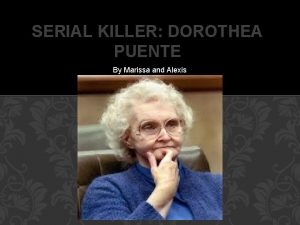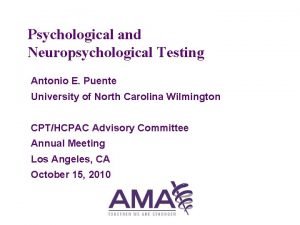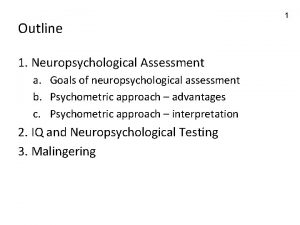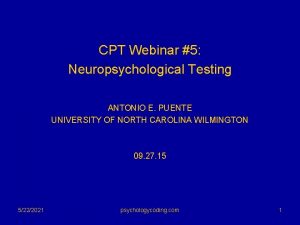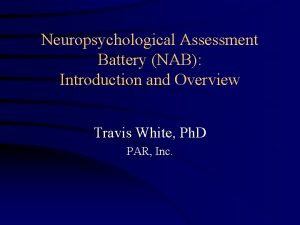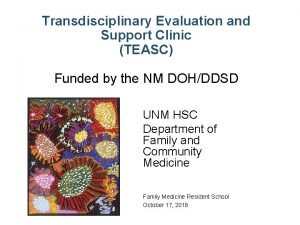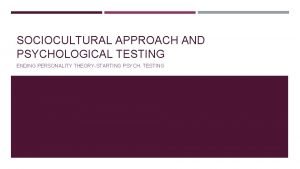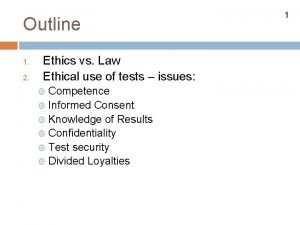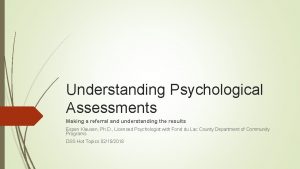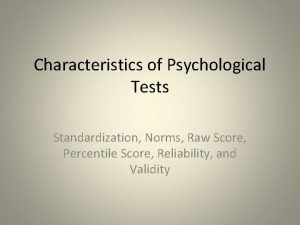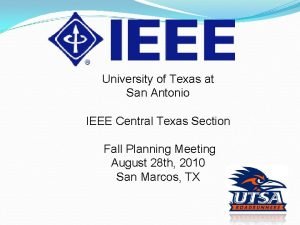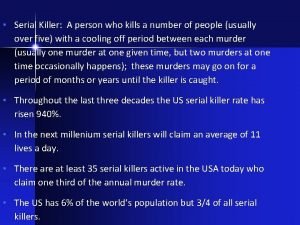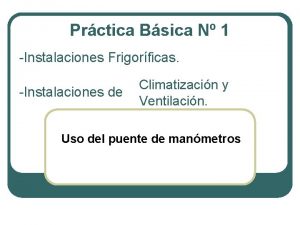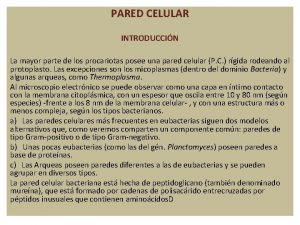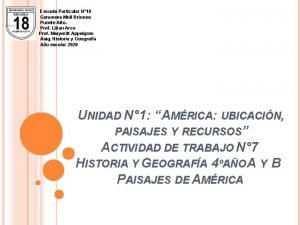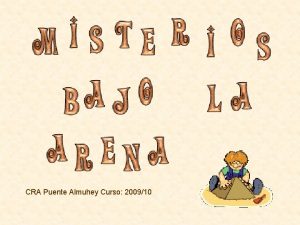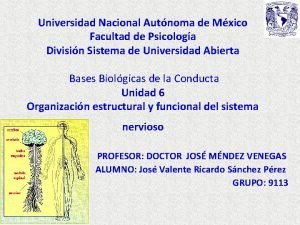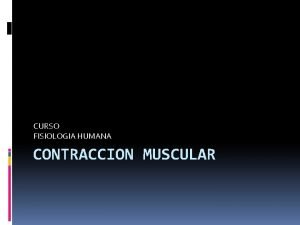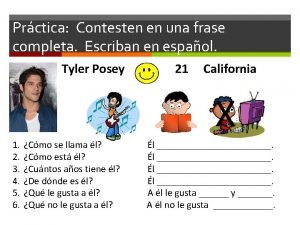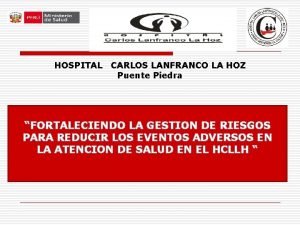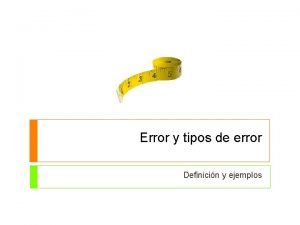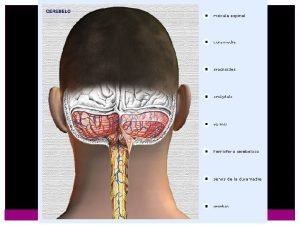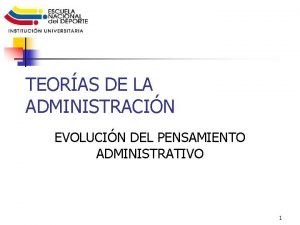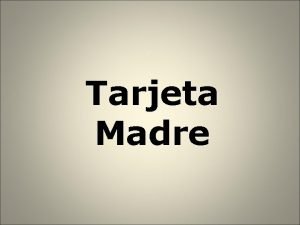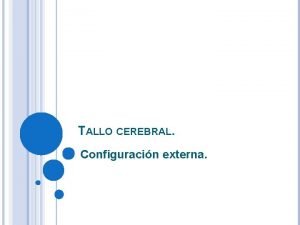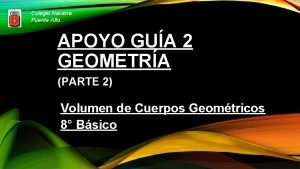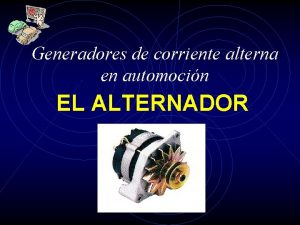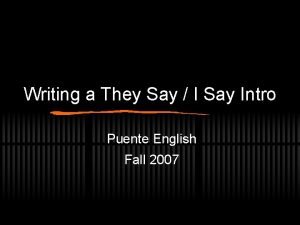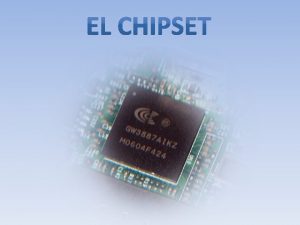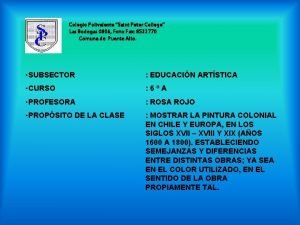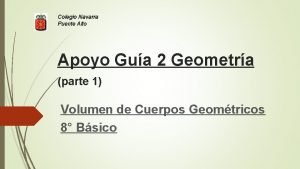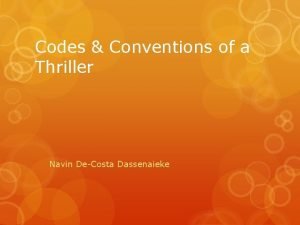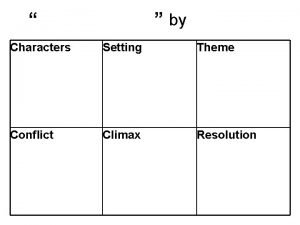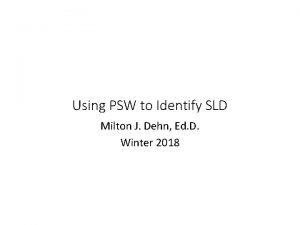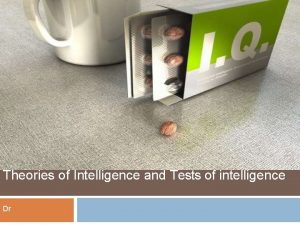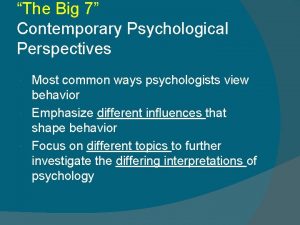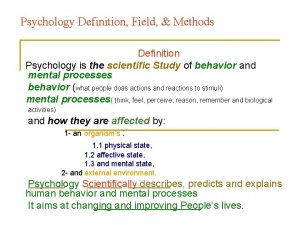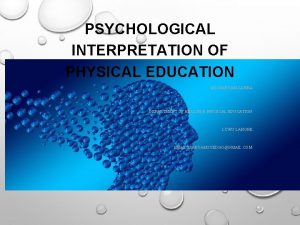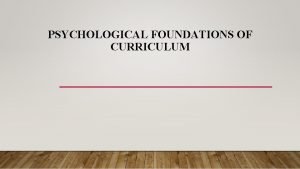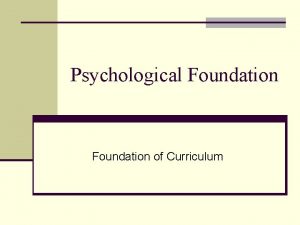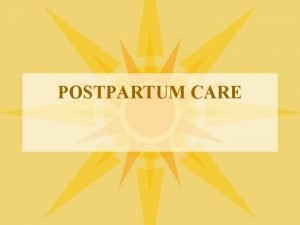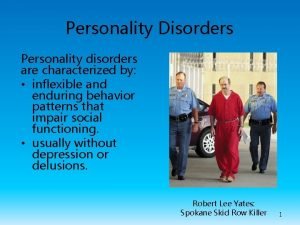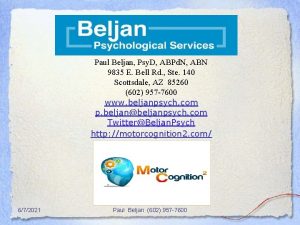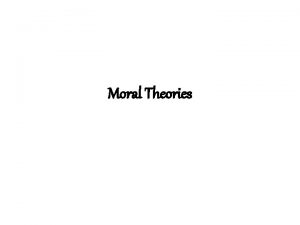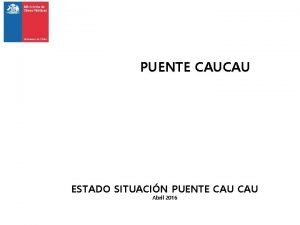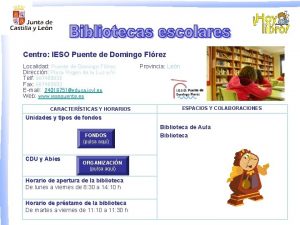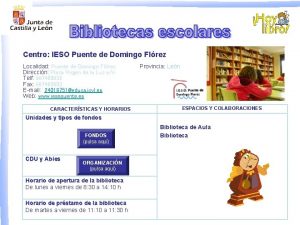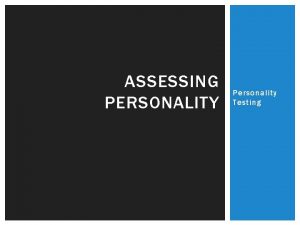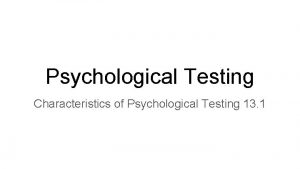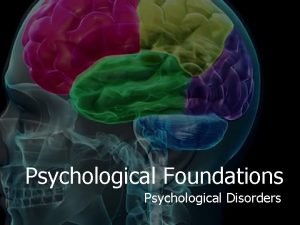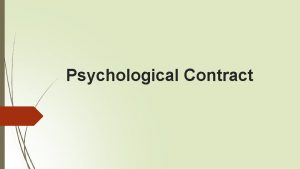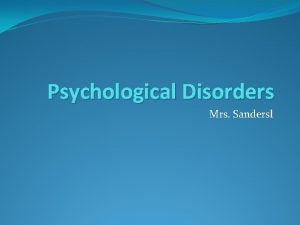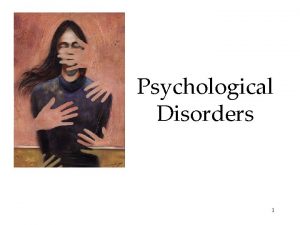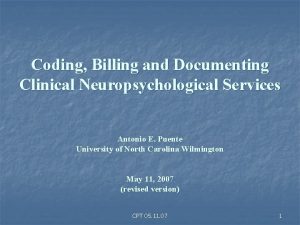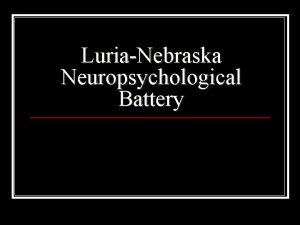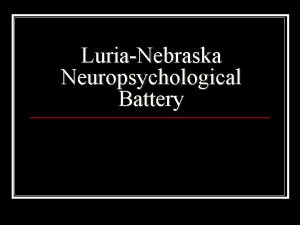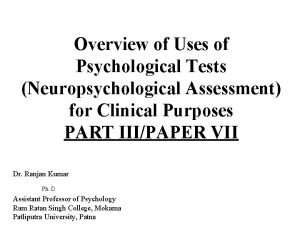Psychological and Neuropsychological Testing Antonio E Puente University


























































































- Slides: 90

Psychological and Neuropsychological Testing Antonio E. Puente University of North Carolina Wilmington CPT/HCPAC Advisory Committee Annual Meeting Los Angeles, CA October 15, 2010

Acknowledgments: Organizations q. North Carolina Psychological Association q. American Medical Association (AMA) CPT Staff q. American Psychological Association (APA) Practice Directorate (PD) q. National Academy of Neuropsychology (NAN) q. Division of Clinical Neuropsychology of APA (40) q. Center for Medicare & Medicaid Services (CMS) Medical Policy Staff- Medicare q. National Academies of Practice (NAP) (presented in chronological order of engagement of support for the work outlined) 2

Acknowledgments: Individuals • AMA: Marie Mindeman, Tracy Gordy • APA: Randy Phelps, Diane Pedulla and Kim Moore along with Marilyn Richmond and Katherine Nordal (APA Testing Group) • NAN: Pat Pimental, Jennifer Morgan • NAP: Marie Di. Cowden • National Psychologist: Paula Hartman-Stein • Other: James Georgoulakis, Neil Pliskin, Pat De. Leon 3

Personal Background (1988 – present) q North Carolina Psychological Association (e) q NAN’s Professional Affairs & Information Committee (a); Division 40 Practice Committee (a) q National Academy of Practice (e) q APA’s Policy & Planning Board; Div. 40; Committee for Psychological Tests & Assessments (e) q Consultant with the North Carolina Medicaid Office; North Carolina Blue Cross/Blue Shield (a) q Health Care Finance Administration’s Working Group for Mental Health Policy (a) q Center for Medicare/Medicaid Services’ Medicare Coverage Advisory Committee (fa) q American Medical Association’s Current Procedural Terminology Committee Advisory Panel – HCPAC (IV/V) (a) q American Medical Association’s Current Procedural Terminology – Editorial Panel (e) q Joint Committee for Standards for Educational and Psychological Tests (a) 4

Outline of Presentation • • • Current Procedural Terminology Diagnosing Documentation Time Technicians Supervision 5

CPT: Copyright • CPT is Copyrighted by the American Medical Association • CPT Manuals May be Ordered from the AMA at 1. 800. 621. 8335 6

CPT: Applicable Codes • Total Possible Codes = Approximately 7, 500 • Possible Codes for Psychology = Approximately 60 • Sections = Five Primary Separate Sections • • Psychiatry (e. g. , mental health) Biofeedback Central Nervous System Assessment (testing) Physical Medicine & Rehabilitation Health & Behavior Assessment & Management Team Conference Evaluation and Management 7

Psychiatry: Interviewing • Psychiatry Interviewing • 90801 • One time per illness incident or bout • Un-timed (est. @ approximately 1. 5 hours) • Comprehensive analysis of records, observations as well as structured and/or unstructured clinical interview • Includes mental status, history, presenting complaints, impression, disposition 8

Psychiatry: Interactive Interviewing • 90802 • As 90801 but could be used with; • Children • Difficult to communicate patients • Professional may us physical aids and/or interpreter 9

Psychiatry: Interview Information • Mental Health History • Chief Complaint • History of Present Illness • General History • • Family Personal Sexual Medical 10

Interview Information/Materials • General Appearance • Attitude Towards Examiner • Speech and Stream of Talk • Emotional Reaction and mood • Perception • Thought Content • Cognition 11

Psychiatric Interviewing (CPT Assistant, March 2010, Volume 20, #3, 68) • Basic Aspects • Medical History • Psychiatric History • Mental Status • Appearance • Attitude • Mental state • Overall behavior • Disposition 12

Psychiatric Interviewing (CPT Assistant, March 2010, Volume 20, #3, 6 -8) • Additional Information • May include collateral communication • May include information in lieu of patient • Extend of mental status depends on condition • Interactive Interviewing • May include physical aids • Non-verbal aids • Language or sign interpreter 13

CNS Assessment Codes : Rationale for Changes of Testing Codes • Avoidance of Continuation of Reimbursement Heavily Based on Practice Expense • Greater Clarification of Activities Including Interviewing and Testing by Professional, Technician and/or Computer • Recognition of Cognitive Work • Great Clarity of What Actual is Happening • Differentiation of Professional, Technical and (nonassisted) Computer Testing • Most Importantly, a Mandate from CMS • Testing Codes Available for Use by Physicians and Psychologists Only (includes neuropsychologists) 14

CPT: CNS Assessment Codes Timetable • Activity x Date • • • • • • Codes Without Cognitive Work Obtained, 1994 Ongoing Discussions with CMS About Lack of Work Value, 1995 -2000 Request by CMS/AMA to Obtain Work Value, approximately 2000 Initial Request for Practice Expense by APA, Summer, 2002 APA Appeared Before AMA RUC, September, 2003 Initial Decision by AMA CPT Panel, November 7, 2004 Call for Other Societies to Participate, November 19, 2004 Final Decision by AMA CPT Panel, December 1, 2004 Submission of CPT Codes to AMA RUC Committee immediately thereafter Review by AMA RUC Research Subcommittee in January, 2005 Review by AMA RUC Panel in February 3 -6, 2005 Survey of Codes, second & third week of February, 2005 Analysis of Surveys, March, 2005 Presentation to RUC Committee in April, 2005 Inclusion in the 2006 Physician Fee Schedule on January 1, 2006 Meeting with CMS, April 24, 2006 CMS Transmittal and NCCI Edits published September, 2006 AMA CPT Assistant articles published November, 2006 AMA CPT Assistant Q & A published December, 2007 Presentation to AMA CPT Panel February 9, 2007 Presentation to CMS a series of Q and As July, 2007 Acceptance and publication of new CPT testing code language, October, 2008 Initial acceptance of clarification of testing codes by CMS, October, 2008 Continued involvement in the explanation of their use (e. g. , AMA CPT presentation, October, 2010) 15

CPT: CNS Assessment AMA CPT Assistant, 03. 06; AMA CPT Assistant, 11. 06, 12. 06 • Psychological Testing (e. g. , 5 units) • Three New Codes • New Numbers & Descriptors • Neurobehavioral Status Exam (e. g. , 2 units) • New Number & Revised Descriptor • Neuropsychological Testing (e. g. , 10 units) • Three New Codes • New Numbers & Descriptors 16

Testing Information • Federal Register, November 21, 2005 at 70 FR 70279 and 70280 under Table 29 and CPT HCPAC Recommendations and CMS Decisions for New and Revised 2006 CPT Codes • MLN Matters Number: MM 5204 17

Reporting Testing Codes • A minimum of 31 minutes must be provided to report any per hour code. Services 96101, 96105, 96116, 96118 and 96125 report time as face-to-face time with the patient and the time spent interpreting and preparing the report. 18

Psychological Testing: By Professional (01. 06) • 96101 –Psychological Testing • Psychological testing (includes psychodiagnostic assessment of emotionality, intellectual abilities, personality and psychopathology, e. g. , MMPI, Rorschach, WAIS) per hour of psychologist’s or physician’s time, both face-to-face time with the patient and time interpreting test results and preparing the report. (estimated total per year Medicare claims = 175, 000) 19

Psychological Testing: By Professional (Revised 02. 09. 07; Implemented 01. 08) (revisions in italic and underlined) • 96101 –Psychological Testing • Psychological testing (includes psychodiagnostic assessment of emotionality, intellectual abilities, personality and psychopathology, e. g. , MMPI, Rorschach, WAIS) per hour of psychologist’s or physician’s time, both face-to-face time administering tests to the patient and time interpreting these test results and preparing the report (96101 is also used in those circumstances when additional time is necessary to integrate other sources of clinical data, including previously completed and reported technician- and computer-administered tests. ) (Do not report 96101 for the interpretation and report of 96102, 96103. ) 20

96101 Explained (AMA CPT Assistant, November, 2006) • “Code 96101 is reported for the psychological test administration by the physician or psychologist with subsequent interpretation and report by the physician or psychologist. I t also is reported for the integration of information obtained from other sources which is incorporated into the interoperation and reports of test administrated by a technician and/or computer. This provides the meaning of the test results in the context of all the testing and assessments. The potentially confusing aspect of this code is that when the physician or psychologist performs the tests personally, the test specific scoring and interpretation is counted as part of the time of 96101. 21

Psychological Testing: By Technician (01. 06) • 96102 - Psychological Testing • Psychodiagnostic assessment of emotionality, intellectual abilities, personality and psychopathology (e. g. , MMPI, Rorschach, WAIS) with qualified health care professional interpretation and report, administered by technician, per hour of technician time, face-toface 22

96102 Explained (AMA CPT Assistant, November, 2006) • The qualified health professional has previously met with the patient and conducted a diagnostic interview. The test instruments to be used by the technician under the supervision of the professional have been selected. The qualified health care professional introduced the patient to the technician who conducts the remainder of the assessment. The qualified health professional meets again with eh patient in order to answer any last questions about the procedures and to inform him or her about the timetable for the results. ” 23

Psychological Testing: By Computer (01. 06) • 96103 - Psychological Testing • Psychodiagnostic assessment of emotionality, intellectual abilities, personality and psychopathology, (e. g. , MMPI) administered by a computer, with qualified health professional interpretation and the report 24

96103 Explained (AMA CPT Assistant, November, 2006) • “The qualified health professional has previously met with the patient and conducted and interview. On the basis of the information gathered from the interview, the professional has selected test instruments that maybe administered by a computer. The qualified health professional installs the computer program/test and instruct the patient on the use of the test. The qualified health processional checks the patient frequently to ensure that he or she is completing the tests correctly. The professional install the next instrument and continuous as before until all tests are completed. The qualified health professional meets again with eh patient in order to answer any last question about the procedures and to inform him or her and about timetable for results. ” 25

Neurobehavioral Status Exam (01. 06; Revised 02. 09. 07; Implemented 01. 08) • 96116 - Neurobehavioral status exam • Clinical assessment of thinking, reasoning and judgment ( e. g. , acquired knowledge, attention, language, memory, planning and problem solving, and visual-spatial abilities) per hour of psychologist’s or physician’s time, both face-toface time with the patient and time interpreting test results and preparing the report 26

96116 Explained (AMA CPT Assistant, November, 2006) • “A neurobehavioral status exam is completed prior to the administration of neuropsychological testing. The status exam involves clinical assessment of the patient, collateral interviews (as appropriate and review of prior records. The interview would involved clinical assessment of several domains including but limited to; thinking, reasoning and judgment, e. g. , acquired knowledge, attention, language, memory, planning and problem solving and visual spatial abilities. The clinical assessment would determine the types of tests and how those tests should be administered. ” 27

Neuropsychological Testing. By Professional (01. 06) • 96118 - Neuropsychological testing • (e. g. , Halstead-Reitan Neuropsychological, WMS, Wisconsin Card Sorting) per hour of the psychologist’s or physician’s time, both face-toface time with the patient and time interpreting test results and preparing the report (estimated total Medicare claims/year = 500, 000) 28

Neuropsychological Testing: By Professional (Revised 02. 09. 07; Implemented 01. 08) (revisions in italic and underlined) • 96118 – Neuropsychological Testing • (e. g. , Halstead-Reitan Neuropsychological, WMS, Wisconsin Card Sorting) per hour of psychologist’s or physician’s time, both face-to-face time administering tests to the patient and time interpreting these test results and preparing the report (96118 is also used in those circumstances when additional time is necessary to integrate other sources of clinical data, including previously completed and reported technicianand computer-administered tests. ) (Do not report 96118 for the interpretation and report of 96119 or 96120. ) 29

96118 Explained (AMA CPT Assistant, November, 2006) • Code 96118 is reported for the neuropsychological test administration by the physician or psychologist with subsequent interpretation and report by the physician, or psychologist. It is also reported for the integration of information obtained from other sources which is then incorporated in the more comprehensive interpretation of the meaning the tests results in the context of all testing and assessments. The administration of the tests is completed for the purposes of a physical health diagnosis. ” 30

Neuropsychological Testing: By Technician (01. 06) • 96119 - Neuropsychological testing • (e. g. , Halstead-Reitan Neuropsychological, WMS, Wisconsin Card Sorting) with qualified health care professional interpretation and report, administered by a technician per hour of technician time, face-to-face 31

96119 Explained (AMA CPT Assistant, November, 2006) • “The qualified health professional has previously gather information from the patient about the nature of the complaint and the history of the presenting problems. Based on the clinical history, a final selection of tests to be administered is made. The procedures are explained to the patient, and the patient is introduced to the technicians, which administers the tests. During testing, the qualified health professional frequently checks with the technician to monitors the patient’s performance and make any necessary modifications to the test battery or assessment plan. When all tests have been administered, the qualified health professional meets with the patient again to answer any questions. ” 32

Neuropsychological Testing. By Computer (01. 06) • 96120 - Neuropsychological testing • (e. g. , WCST) administered by a computer with qualified health care professional interpretation and the report 33

96120 Explained (AMA CPT Assistant, November, 2006) • “Code 96120 is reported for the computeradministrated neuropsychological testing, with subsequent interpretation and report of the specific tests by the physician, psychologist, or other qualified health care professional. This should be reserved for situations where the computerized testing is unassisted by a provider or technician other than the installation of programs/test and checking to be sure that the patient is able to complete the tests. If grater levels of interaction are required, though the test may be computerized administer, then the appropriate physician/psychologist (96118) or technician code (96119) should be used. ” 34

Coding Tip (AMA CPT Assistant, November, 2006) • “If the service is provided is less than one hour, append Modifier 52, Reduced Services. After one hour has been completed, time is rounded. ” • “It is not unusual that the assessments may include testing by a technician and a computer with interpretation and report by the physician, psychologist or qualified health professional. Therefore, it is appropriate in such cases to report all 3 codes in the family of 96101 -96103 -or 96118 -96120. ” 35

Coding Tip (AMA CPT Assistant, November, 2006) • “All of the testing and assessment services also require interpretation in the context of other clinical assessments performed by a qualified professional as well as prior records. The use of the term “interpretation” in thee codes is this integrative process. It is not the scoring or interpretation of the result of a specified tests or tests. The scoring process and more limited interpretation is part of the test administration services whether by physician/psychologist, technician and/or computer. ” 36

Code Usage (AMA CPT Assistant, November, 2006) • “Typically, the psychological testing services, 96101 -96103 -, the neurobehavioral status exam, 96116, and the neuropsychological testing services, 96118 -96120, are administered once per illness condition or when a significant change in behavior and/or medical/health condition necessitates reevaluation. ” 37

Additional Supporting Information • CMS Manual • Pub 100 -02 Medicare Benefit Policy • Change Request 5204 • Transmittal 85 • February 25, 2008 • (reference Transmittal 55; Change Request 5204; September 29, 2006) 38

Code Frequency Use Code 2006 2007 2008 90801 1, 349, 524 1, 334, 007 1, 351, 838 96101 176, 045 180, 328 190, 913 96102 13, 455 12, 929 13, 009 96116 102, 387 108, 470 109, 014 96118 387, 813 416, 887 460, 327 96119 95, 341 89, 640 96, 151 39

Code Information Code Locale Over 75 Specialty Dx 90801 Opt. Office 39% Psy. MD(cp) Mood Dsd. 96101 Opt. Office 32% CP Mood 96102 Opt. Office 36% CP PPD 96116 Opt. Office 64% CP PPD/Dement. 96618 Opt. Office 55% CP PPD/Dement. 96619 Opt. Office 46% CP PPD/Dement. 40

Tests Performed by Technicians & Computers • Effective January 1, 2006, CPT Codes for psychological and neuropsychological tests performed by technicians and computers (CPT codes 96102, 96103, 96119 and 96120) in addition to tests performed by physicians, clinical psychologists, independently qualified practicincing psychologists and other qualified nonphysiciand practittioners. ID 9176, Created 06/17/2008, 11: 21 am; Last updated 06/09/2009 01: 41 PM October 23, 2008 41

Simultaneous Use of Professional and Technical Codes • Currently Allowed by Medicare • https: //questions. cms. hhs. gov/cgibin/cmshhs. cfg/php/enduser/print_alp. php? faq_arr ay=9177, 9179, 9176, 9180, 9181, 9182, 9183, 9178> • MLN Matters: MM 5204 Revised, Effective December 28, 2006 • Most conservative; modifier 59 and one test by professional 42

Simultaneous Use of Testing Codes 1. When the provider administers at least one of the tests, then pre-existing problems with the simultaneous use of two testing codes do not apply (Niles Rosen, M. D. , NCCI, Personal Communication, November, 2009) 2. When the professional and the technical services are not provided on the same date. 43

Simultaneous Codes: NCCI (AMA Code Manager, 2009; Section M) • “Two or more codes may be reported on the same date of service if and only if the different testing techniques are utilized for different neuropsychological tests” 44

Potential Problems with Simultaneous Use of Test Codes • Some insurance companies may be excluding the use of professional and technical codes simultaneously • Ingenix, Mc. Kessons other computerized edit systems, may be disallowing simultaneous test codes • Compliance officers at large institutions 45

Modifier 59 & Testing Codes • Modifier is not applicable if the professional provides the service. • If the technician provides the service, it is advisable (pending MAC guidelines) to use the 59 modifier. • The modifier should be applied to any of the testing codes though probably best to attach to technician and/or computer codes (CMS, September, 2006) 46

Official Q & As from CMS Regarding Testing Codes • (https: //questions. cms. hhs. gov/cgibin/cmshhs. cfg/php/enduser/print_alp. php? faq _array=9177, 9179, 9176, 9180, 9181, 9182, 918 3, 9178) • Probably will not be further revised and additional concerns will be handled at the local carrier level 47

Simultaneous Use of 90801 and 96116 • Under No Circumstances are the Psychiatric (90801) and Neurobehavioral Status Examination (96116) are to be Used Simultaneously 48

CNS Assessment Examples • Neurobehavioral Status with Neuropsychological Testing • Interview by the Professional • Testing by • Professional, and/or • Technician, and/or • Computer. • Interpretation & Report Writing by Professional • A Technician or Computer Code are “Typically” Billed Together with a Professional Code Assuming that Different Services are Being Provided (since the final product should be a comprehensive/integrative report) 49

Other Testing Codes: Developmental Testing • Developmental Testing Codes • Applicability • Children • Background • Part of Central Nervous System family of codes • Hence, no work value (& lower reimbursement rate) • Recently “re-surveyed” by pediatricians • Specific Changes • 96110 • Continues to have no work value • Use for completion of forms (Connors; by parents) • 96111 • Has physician work value • Assessment of child’s social, emotional, etc status (WJ) 50

Relatively New Code: f. MRI • 96020 - Functional Brain Mapping • Neurofunctional test selection and administration during non-invasive imaging functional brain mapping with test administered entirely by a physician or psychologist with review of test results and report • (vs. diagnostic radiology imaging) 51

Functional Brain Mapping • 96020 and 70555 were established to report neurofunctional brain mapping of blood changes in the brain by MRI in response to tests administered by physicians and psychologists correlating to specific brain functions (e. g. , motor skills, vision, language and memory). 52

Functional Brain Mapping • Functional brain mapping should be used with patients with; • Brain neoplasms • Arteriovenous malformations • Intractable epilepsy • Other brain lesions that may require invasive or focal treatment 53

Functional Brain Mapping • 96020 is used to report neurofunctional test selection and administration during noninvasive imaging Functional Brain Mapping, with test administration entirely by a physician or psychologist, with review of test results and report. • Measurement of; • • • Language Memory Cognition Movement Sensation Other neurological functions 54

New Cognitive Testing Code for Use by OT, ST and Others • 96125 – Standardized Cognitive Performance Testing • (e. g. , Ross Information Processing Assessment). • (For psychological and neuropsychological testing by a physician or psychologist, see 96101 -96103 - 96118 -96120) 55

Telehealth Services (http: //www. cms. hhs. gov/manuals/102_policy/bp 102 index. asp) • Effective 01. 08, 96116 is available as a Tele. Medicine/Telehealth Code • Remote patient face-to-face services seen via live video conferencing • To be used in rural areas or where there a shortage of providers • Non face-to-face services that can be conducted either through live vide conferencing or via “store and forward” telecommunication services • Home telehealth services • Must be submitted with modifier “GT” (telehealth modifier) 56

Telehealth Services • Individual Psychotherapy • Psychiatric Diagnostic Interviewing • Neurobehavioral Status Exam • Presently discussing Testing Services 57

Health & Behavior: Assessment • 96150 • Health and behavior assessment (e. g. , health-focused clinical interview, behavioral observations, psychophysiological monitoring, health-oriented questionnaires) • each unit = 15 minutes • face-to-face with the patient • initial assessment • 96151 • re-assessment • each unit = 15 minutes • Face-to-face with the patient 58

H & B: Assessment Explanation • Identification of Psychological, Behavioral, Emotional, Cognitive and/or Social Factors • In the Prevention, Treatment and/or Management of Physical Health Problems • Focus on Biopsychosocial and not Mental Health Factors 59

H & B: Assessment Examples • Health-Focused Clinical Interview • Behavioral Observations • Psychophysiological Monitoring • Health-Oriented Questionnaires 60

Documentation: Assessment • Identifying Information • Reason for Service • Dates • Time (amount of service time; total Vs. actual) • Identity of Tester (technician? ) • Tests and Protocols (included editions) • Narrative of Results • Impression(s) or Diagnosis(es) • Disposition 61

Documentation: “Assessment” Based on New Interpretation of Codes • Technical Component • Label • Testing by Technician • Information • Individual Tests • Numerical • Basic Qualitative • Professional Component • Label • Examples; Integration of Findings, Testing by Professional • Interpretation • Integration of findings which may include history, prior records, interview(s), and compilation of tests 62

Documentation: H & B Codes • Must show evidence of coordination of care with the patient’s primary medical care providers or medical provider for the medical management of the physical illness that the H & B activity was meant to address. 63

Documentation: H & B Assessment • Onset and history of initial diagnosis of physical illness • Clear rationale why the assessment is required • Assessment outcome including mental status and ability to understand or respond meaningfully • Measurable goals and expected duration of specific interventions 64

Documentation: CPT X Report • Each CPT Code Should Generate a Separate Report (or at least a separate section) • If Separate Sections Within One Report, Clearly Label/Title Sections of the Report to Match Code Used (e. g. , Neuropsychological Testing by Technician) 65

Documentation: Suggestions • Consider Having a Multi-level System of Documentation; • Raw data (e. g. , test protocols) • Internal routing sheets documenting such information as start/stop time, technician name, dates, etc. (a master sheet could track technician as well as professional time) • Final report 66

Time • Time is Broadly Defined as What the Professional Does • For Intervention – Time is face-to-face • For Assessment - Time could be either faceto-face (i. e. , H & B) or professional time (e. g. , Psych & Neuropsych) 67

Recent Interpretations of Time • Non face-to-face time (pre and post) sometimes is not included in the measurement of billed time but it has been included in calculating total work of the service during the survey process. • A unit of time is obtained when the mid-point has passed. • When a time service is reported along with a non-timed service, the two are not added. 68

Time: Definition (CPT Assistant, 08. 05, 15, #8, pg. 12) (www. cms. hhs. gov/providers/therapy) • For Timed Codes in Physical Medicine: Beginning and Ending Time Should be Documented • Time Should be Documented Along with the Treatment Description 69

Time: Defining 60 Minutes “The Rounding Rule” • 1 unit > or equal to 31 minutes to < 91 minutes • 2 units > or equal to 91 minutes to < 151 mns. • 3 units > or equal to 151 minutes to < 211 s mns. • 4 units > or equal to 271 minutes to < 331 mns. • And so on… 70

Location of Time • Intraservice times are defined as face-to-face time for office and other outpatient visits and as unit/floor time for hospital and other inpatient visits. This distinction is necessary because most of the work of typical office visits takes place during the face-to-face time with the patient, while most of the work of typical hospital visits takes place during the time spent on the patient's floor or unit. 71

Time: Quantifying for Testing • Quantifying Time • Round up or down to nearest increment • Actual time not elapsed time (I. e. , start/stop times) • Time Does Not Include • Patient completing tests, scales, forms, etc. • Waiting time by patient • Typing of reports • Non-Professional (e. g. , clerical) time • Literature searches, learning new techniques, etc. 72

Time: Suggestions for Documentation • Therapy • Minimum: Date(s) Total Time Elapsed • Maximum: Date(s) Start and Stop Times • Testing • Minimum: Date(s) & Total Time Elapsed • Maximum: Date(s) Start and Stop Times • Backup • Scheduling System (e. g. , schedule book; agenda, etc) • Testing Sheet with Lists of Tests with Start/Stop Times • Keep Time Information as Long as Records Are Kept 73

Technicians • What is the Minimum Level of Training Required for a Technician? • Malek-Ahmadi, M. , Erickson, T. , Puente, A. E. , Pliskin, N. , & Rock. R. (in press). The use of psychometrists in clinical neuropsychology: History, current status and future directions. Applied Neuropsychology. • National Association of Psychometrists/Board of Certified Psychometrists • www. napnet. org/www. psychometriciancertification. org • 40 & NAN Position Paper • Level of Education- Minimum of Bachelors • Level of Training • Level of Supervision 74

Technician: Definition Federal Register, Vol. 66, #149, page 40382 • Requirement • Employee (e. g. , 1099); “employees, leased employees, or independent contractor” • Most common is independent contractor • “We do not believe that the nature of the employment relationship is critical for purposes of payment to the services of physician…as long as…(the personnel) is under the required level of supervision. ” • Common Practice • Independent Contractor • In Institutional Settings – institutional contract (source- NAP) 75

Technician: 1500 Forms • HCFA/CMS Line 25 • This is the line that identifies in a common insurance form who is the “qualified health provider” that is responsible for and completing the service • That individual is the person with whom the contractual relationship is established • Anybody else, from high school graduate to post-doctoral fellow to independently licensed psychologist (but not contractually related professional), is, for all practical purposes, a technician • That technician is not a new class of provider and cannot bill independently of a doctoral level provider 76

Technician: Federal Government’s Definition • DM & S Supplement, MP-5, Part I • Authority: 38 U. S. C. 4105 • Appendix 17 A Change 43 • Psychology Technician GS-181 -5/7/9 • Definition • Bachelor’s degree from accredited college/university with a major in appropriate social or biological sciences (+ 12 psy. hours) 77

Technician: NAN’s Definition • Approved by NAN Board of Directors • 08. 2006 • Archives of Clinical Neuropsychology- • 2006 (e. g. , Puente, et al) 78

Technician: NAN’s Definition Explained • • • Function- administration & scoring of tests Responsibility- supervisor Education- minimum, bachelor’s level Training- include ethics, neuropsy, psychopath, testing Confidentiality- APA ethics, HIPAA… Emergencies- contingencies must be in place Cultural Sensitivity- must be considered Supervision- general (Medicare) level Contract- must be in place Liability Insurance- must be in place 79

Technicians: Application • Practice Expense & Practice Implications • Each tech code has. 51 work value • This means that the professional is engaged in the work, namely, supervision (and interpretation) • That supervision would include; • • • Selection of tests Determination of testing protocol Supervision of testing Interpretation of individual tests Reporting on individual tests Assisting with concerns raised by the patient 80

Technicians: Interfacing with Professionals • The Qualified Health Provider must; • • See the patient first Supervise the activity Interpret and write the note/report Engaged in an ongoing capacity NOTE: Pattern similar to medical and other health providers 81

Technicians: Facility • Technicians in a “Facility” • A “facility” in essentially an inpatient setting • If a technician is an employee of a private provider but the service is provided in an inpatient setting, the inpatient fee would be used • If a technician is an employee of a facility, there is some question as to whether they could be supervised by a provider who is not an employee of the facility 82

Students as Technicians • Medicare Interpretation • Medicare has never reimbursed for student training for any health disciplines • The assumption is that GME pays training programs and double dipping would occur if the Medicare and the CPT reimbursed for student activity • Two caveats: • This limitation probably applies to Medicare only • Students can perform as technicians as long as they are not being trained and their activity is not part of their educational requirements (e. g. , a neuropsychologist in the community employees the student as a technician in their practice) 83

Supervision ( Federal Register, 69, #150, August 5, 2004, page 47553) • Hold Doctoral Degree • Licensed or Certified as a Psychologist or Physician • Applicable Only to “clinical psychologists” (and not “independent” psychologists as defined by Medicare) • Rationale • Allows for higher level of expertise to supervise • Could relieve burden on physicians and facilities • May increase services in rural areas 84

Supervision Program Memorandum Carriers Department of Health and Human Services- HCFA Transmittal b-01 -28; April 19, 2001 • Levels of Supervision • General • Furnished under overall direction and control, presence is not required • Direct • Must be present in the office suite and immediately available to furnish assistance and direction throughout the performance of the procedure • Personal • Must be in attendance in the room during the performance of the procedure 85

Supervision: Levels 42 CFR 410. 32 • According to Medicare published guidelines as of July, 2006; • General- activity is directed and supervised by the doctoral level provider but the provider does not need to be in office suite 86

AMA Contact Information • Website • www. amabookstore. com • Link to; • catalog. ama-assn. org/Catalog/cpt/issue_search. jsp • Telephone • 1 800 621 -8335 87

APA Contact Information • American Psychological Association - Katherine Nordal, Ph. D. Practice Directorate, Director American Psychological Association 750 First Street, N. W. Washington, D. C. 2002 • Association for the Advancement of Psychology • www. aapnet. org • P. O. Box 38129 • Colorado Springs, Colorado 38129 88

Puente Contact Information • Websites • Univ = • Practice = www. uncw. edu/people/puente www. clinicalneuropsychology. us • NAN = • Div 40 = www. nanonline. org/paic www. div 40. org • E-mail • University = • Practice = puente@uncw. edu clinicalneuropsychology@gmail. com • Telephone • University = • Practice = 910. 962. 3812 910. 509. 9371 89

 Dorothea puente young
Dorothea puente young Psychological testing examples
Psychological testing examples Goals of neuropsychological assessment
Goals of neuropsychological assessment 96118 neuropsychological testing
96118 neuropsychological testing Fixed battery approach
Fixed battery approach Unm center for neuropsychological services
Unm center for neuropsychological services Psychological testing examples
Psychological testing examples Sfeedtest
Sfeedtest Sample referral question for personality assessment
Sample referral question for personality assessment What is raw score in psychology
What is raw score in psychology Positive and negative testing
Positive and negative testing Cs 3250
Cs 3250 San antonio university
San antonio university Domain testing example
Domain testing example Motivational overview in software testing
Motivational overview in software testing Data flow testing strategies in software testing
Data flow testing strategies in software testing Globalization testing
Globalization testing Functional testing vs unit testing
Functional testing vs unit testing Cause effect graphing technique
Cause effect graphing technique Control structure testing in software engineering
Control structure testing in software engineering Decision table testing in software testing
Decision table testing in software testing Decision table testing
Decision table testing Black box testing adalah
Black box testing adalah Black-box testing disebut juga sebagai behavioral testing
Black-box testing disebut juga sebagai behavioral testing Extended entry decision table
Extended entry decision table Rigorous testing in software testing
Rigorous testing in software testing Testing blindness in software testing
Testing blindness in software testing Component testing is a black box testing
Component testing is a black box testing Software testing domains
Software testing domains Dorothea puente victimology
Dorothea puente victimology Mapa de aeropuertos en argentina
Mapa de aeropuertos en argentina Puente manometrico
Puente manometrico Partes de la pared celular
Partes de la pared celular Escuela genoveva moll briones
Escuela genoveva moll briones Cra puente almuhey
Cra puente almuhey Colegio navarra puente alto
Colegio navarra puente alto Puente mesencefalo
Puente mesencefalo Eminencia teres
Eminencia teres Que ninguna familia se acabe por falta de amor significado
Que ninguna familia se acabe por falta de amor significado Puente monumental medellín
Puente monumental medellín Contraccion muscular
Contraccion muscular Puente bilbao
Puente bilbao Debajo del puente había una serpiente
Debajo del puente había una serpiente Puente nb
Puente nb Puente piedra
Puente piedra Puente camarones
Puente camarones Ejemplo de error de truncamiento
Ejemplo de error de truncamiento Jaime puente
Jaime puente Puente cerebeloso
Puente cerebeloso Puente de fayol
Puente de fayol Faja scsi
Faja scsi Tuberculo trigeminal
Tuberculo trigeminal Principio del electromagnetismo
Principio del electromagnetismo Colegio navarra puente alto
Colegio navarra puente alto Puente rectificador nanodiodo
Puente rectificador nanodiodo They say i say thesis
They say i say thesis Chipset puente norte
Chipset puente norte Descuentos en dimeiggs
Descuentos en dimeiggs Colegio saint peter college
Colegio saint peter college Colegio navarra puente alto
Colegio navarra puente alto Andrea de la puente
Andrea de la puente Andrea de la puente
Andrea de la puente Ksu counseling and psychological services
Ksu counseling and psychological services Codes and conventions of psychological thriller
Codes and conventions of psychological thriller 詹景裕
詹景裕 Theseus ariadne
Theseus ariadne Conflict climax resolution
Conflict climax resolution What role did erasmo seguin and jose antonio navarro
What role did erasmo seguin and jose antonio navarro Alliteration in merchant of venice
Alliteration in merchant of venice Milton dehn
Milton dehn Misic psychological test
Misic psychological test Psychological harassment
Psychological harassment Linear communication model
Linear communication model Psychological perspectives
Psychological perspectives Chapter 18 psychological disorders review worksheet
Chapter 18 psychological disorders review worksheet What is field methods in psychology
What is field methods in psychology Psychological thriller subgenre
Psychological thriller subgenre The pupil by henry james
The pupil by henry james Psychological interpretation of physical education
Psychological interpretation of physical education Learning is explained in terms of wholeness of the problem
Learning is explained in terms of wholeness of the problem Behaviorism curriculum
Behaviorism curriculum Psychological first aid
Psychological first aid Outline one psychological explanation of schizophrenia
Outline one psychological explanation of schizophrenia Psychological approach in literature
Psychological approach in literature What is a psychological lens in literature
What is a psychological lens in literature Rubin's phases of postpartum change
Rubin's phases of postpartum change Ethical egoism
Ethical egoism Inflexible personality
Inflexible personality The barnum effect
The barnum effect Beljan psychological services
Beljan psychological services Moral theory definition
Moral theory definition
